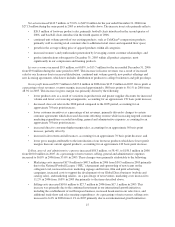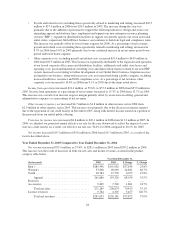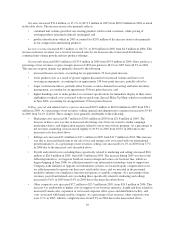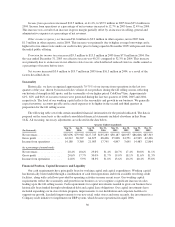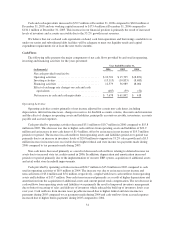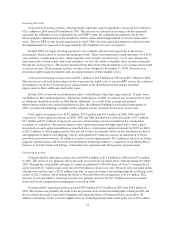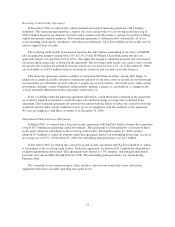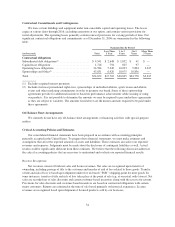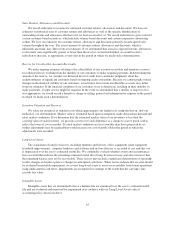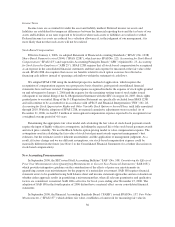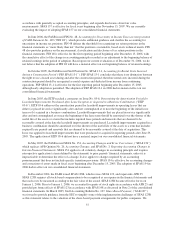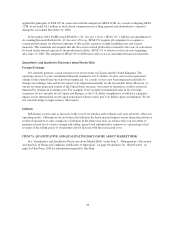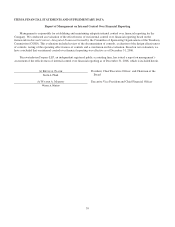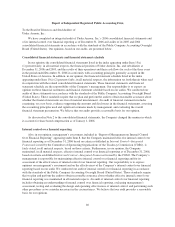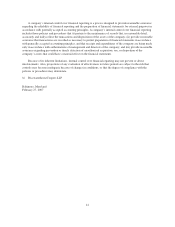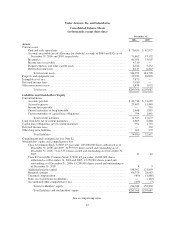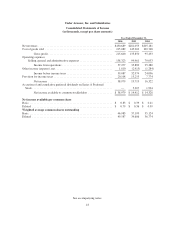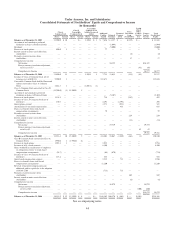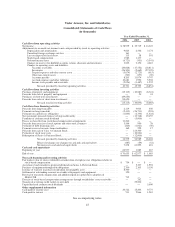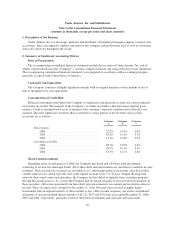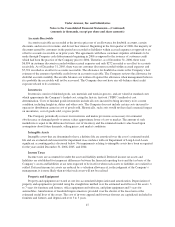Under Armour 2006 Annual Report Download - page 45
Download and view the complete annual report
Please find page 45 of the 2006 Under Armour annual report below. You can navigate through the pages in the report by either clicking on the pages listed below, or by using the keyword search tool below to find specific information within the annual report.accordance with generally accepted accounting principles, and expands disclosures about fair value
measurements. SFAS 157 is effective for fiscal years beginning after November 15, 2007. We are currently
evaluating the impact of adopting SFAS 157 on our consolidated financial statements.
In June 2006, the FASB issued FIN No. 48, Accounting for Uncertainty in Income Taxes-an interpretation
of FASB Statement No. 109 (“FIN 48”), which provides additional guidance and clarifies the accounting for
uncertainty in income tax positions. FIN 48 defines the threshold for recognizing tax return positions in the
financial statements as “more likely than not” that the position is sustainable, based on its technical merits. FIN
48 also provides guidance on the measurement, classification and disclosure of tax return positions in the
financial statements. FIN 48 is effective for the first reporting period beginning after December 15, 2006, with
the cumulative effect of the change in accounting principle recorded as an adjustment to the beginning balance of
retained earnings in the period of adoption. Based upon our current evaluation as of December 31, 2006, we do
not believe that the adoption of FIN 48 will have a material effect on our beginning balance of retained earnings.
In October 2005, the FASB issued Staff Position No. SFAS 13-1, Accounting for Rental Costs Incurred
during a Construction Period (“FSP SFAS 13-1”). FSP SFAS 13-1 concludes that there is no distinction between
the right to use a leased asset during and after the construction period; therefore rental costs incurred during the
construction period should be recognized as rental expense and deducted from income from continuing
operations. FSP SFAS 13-1 is effective for the first reporting period beginning after December 15, 2005,
although early adoption is permitted. The adoption of FSP SFAS 13-1 in 2006 had no material effect on our
consolidated financial statements.
In June 2005, the EITF reached a consensus on Issue No. 05-6, Determining the Amortization Period for
Leasehold Improvements Purchased after Lease Inception or Acquired in a Business Combination (“EITF
05-6”). EITF 05-6 addresses the amortization period for leasehold improvements in operating leases that are
either (a) placed in service significantly after and not contemplated at or near the beginning of the initial lease
term or (b) acquired in a business combination. Leasehold improvements that are placed in service significantly
after and not contemplated at or near the beginning of the lease term should be amortized over the shorter of the
useful life of the assets or a term that includes required lease periods and renewals that are deemed to be
reasonably assured at the date the leasehold improvements are purchased. Leasehold improvements acquired in a
business combination should be amortized over the shorter of the useful life of the assets or a term that includes
required lease periods and renewals that are deemed to be reasonably assured at the date of acquisition. This
Issue was applied to leasehold improvements that were purchased or acquired in reporting periods after June 29,
2005. The application of EITF 05-6 did not have a material impact on our consolidated financial statements.
In May 2005, the FASB issued SFAS No. 154, Accounting Changes and Error Corrections, (“SFAS 154”)
which replaces APB Opinion No. 20, Accounting Changes, and SFAS No. 3, Reporting Accounting Changes in
Interim Financial Statements. SFAS 154 applies to all voluntary changes in accounting principle and requires
retrospective application (a term defined by the statement) to prior periods’ financial statements, unless it is
impracticable to determine the effect of a change. It also applies to changes required by an accounting
pronouncement that does not include specific transition provisions. SFAS 154 is effective for accounting changes
and corrections of errors made in fiscal years beginning after December 15, 2005. The adoption of SFAS 154 in
2006 had no effect on our consolidated financial statements.
In December 2004, the FASB issued SFAS 123R, which revises SFAS 123, and supersedes APB 25.
SFAS 123R requires all stock-based compensation to be recognized as an expense in the financial statements and
that such costs be measured according to the fair value of the award. SFAS 123R became effective for us on
January 1, 2006. Prior to January 1, 2006, we accounted for grants of stock rights in accordance with APB 25 and
provided pro forma effects of SFAS 123 in accordance with SFAS 148 as discussed in Note 2 of the consolidated
financial statements. In March 2005, Staff Accounting Bulletin No. 107, Share-Based Payment, (“SAB 107”)
was issued to provide guidance from the SEC to simplify some of the implementation challenges of SFAS 123R
as this statement relates to the valuation of the share-based payment arrangements for public companies. We
37


